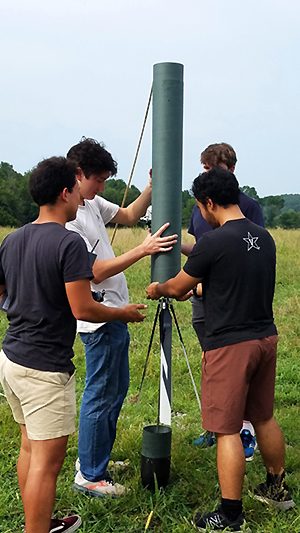Vanderbilt engineering students Rais Nurhidajat, Jonathan Zak, Leo Brenes, and graduate student Andrew Noonan gained invaluable aerospace career experience this summer at the Vanderbilt Aerospace Design Laboratory (VADL). Their project, developing an autorotative lander, advanced their technical skills and provided a springboard for their future careers in the aerospace industry.
An autorotative lander slows itself down through spin much like a winged maple seed floats to the ground. Such a lander is energy efficient because it doesn’t need a motorized device or a parachute to reduce speed. Autonomous aerial vehicles with autorotative landers find applications in reconnaissance and surveying operations, especially in hazardous environments.

Brenes, set to pursue graduate study in Control and Dynamics Engineering at Caltech, said the project enhanced his understanding of flight stability and control. Nurhidajat, an ROTC student commissioning into the Army National Guard as an Apache helicopter pilot, gained crucial design and field engineering insights directly applicable to his future role. Zak, preparing for graduate study in rocket airframe structural health monitoring at Vanderbilt, sees this experience as foundational for his upcoming collaborative project with NASA Armstrong Flight Research Center. Noonan, a master’s student who will graduate in spring 2025, is eager to be at the forefront of the contemporary space launch industry in leadership role.
“Finishing undergrad last year, I just felt there were more opportunities to learn and absorb that I did not want to leave on the table,” Noonan said. “My time at VADL has shaped my career aspirations and fostered an appreciation for developing critical problem solving skills that will be useful in the Space Launch industry.”
The project, motivated by the NASA Student Launch Challenge, exemplifies the power of experiential learning in aerospace engineering. “Experiential learning is an invaluable component in aerospace engineering. We’ve been lucky to find practicing engineers and hobbyist-well-wishers in the Middle Tennessee community who have assisted us in field engineering tests in rocketry and drone flights that enrich our experiential program,” A.V. Anilkumar, Mark Dalton Director of Experiential Learning in Aerospace Engineering and director of VADL.
The students spent their summer working on the design of an autorotative lander designed to self-propel and land vertically when released from a height of 400 feet. The fast-paced design-to-build challenge allowed them to progress from conceptualization to product development and field testing, mirroring real-world aerospace engineering processes.
“Autorotation is a very important functional process in stabilizing a helicopter for emergency landing and there has been quite a bit of focus on this phenomenon. Taking the concept toward a product and field testing has been a great challenge for the students,” said Anilkumar.

Rais Nurhidajat explained the technical aspects: “The blades and their pitch on the autorotative lander have been selected such that they can optimally spin up and produce the necessary thrust to slow the 5-pound craft down for a stable flight and secure landing.” Nurhidajat said the project has given him practical insights that will be valuable as an Apache pilot.
Jonathan Zak added, “The design of the lander was stimulated by a research paper we read, and we’re very satisfied with the flight and its stability. We’ve fully understood the role of blade pitch, span and aspect ratio in determining flight trajectory and dynamics.”
About half of VADL alumni head to graduate school in aerospace engineering and the other half directly enter the contemporary space launch industry, according to Anilkumar. “It has been inspiring to see so many VADL alumni go on to do amazing things in the space industry and I hope to follow in their footsteps,” Zak said.
Brenes continued working at VADL this summer because he was a rocket team member and wanted more experience before starting his PhD program. “I chose CalTech because of its academic excellence and its Jet Propulsion Laboratory that builds and operates many of NASA’s robotic missions.”
VADL, created in 2007, has entered a rocket in the NASA Student Launch Challenge since 2010 and won numerous awards. Other lab activities include presentation of project results at American Institute of Aeronautics and Astronautics student conferences and publishing research in select AIAA journals. VADL also represents the AIAA Student Chapter at Vanderbilt.
Contact: brenda.ellis@vanderbilt.edu